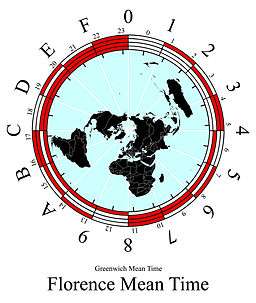Hexadecimal time
Hexadecimal time is the representation of the time of day as a hexadecimal number in the interval [0,1).


The day is divided into 1016 (1610) hexadecimal hours, each hour into 10016 (25610) hexadecimal minutes, and each minute into 1016 (1610) hexadecimal seconds.
History
This time format was proposed by the Swedish-American engineer John W. Nystrom in 1863 as part of his tonal system.[1]
In 1997, the American Mark Vincent Rogers of Intuitor proposed a similar system of hexadecimal time and implemented it in JavaScript as the Hexclock.[2]
Implementation
A day is unity, or 1, and any fraction thereof can be shown with digits to the right of the hexadecimal separator. So the day begins at midnight with .0000 and one hexadecimal second after midnight is .0001. Noon is .8000 (one half), one hexadecimal second before was .7FFF and one hexadecimal second before next midnight will be .FFFF.
Intuitor-hextime may also be formatted with an underscore separating hexadecimal hours, minutes and seconds. For example:
Clock
| Hex | Hex (Boardman) | ISO 8601 | Comment |
|---|---|---|---|
| .0100 | 0_10_0 | 00:05:37.5 | |
| .0200 | 0_20_0 | 00:11:15 | |
| .0400 | 0_40_0 | 00:22:30 | |
| .0800 | 0_80_0 | 00:45:00 | |
| .1000 | 1_00_0 | 01:30:00 | 1.5:24 = 1:16 = 0.1 |
| .8000 | 8_00_0 | 12:00:00 | 12:24 = 8:16 = 0.8 |
| .F000 | F_00_0 | 22:30:00 | 22.5:24 = 15:16 = 0.F |
| .F800 | F_80_0 | 23:15:00 |
Conversions
| Hex | hexsec base 16 |
hexsec base 10 |
Traditional | |||
|---|---|---|---|---|---|---|
| 1 day | = | 10000 | = | 65536 | = | 24 h |
| 1 hexadecimal hour | = | 1000 | = | 4096 | = | 1 h 30 min |
| 1 hexadecimal maxime | = | 100 | = | 256 | = | 5 min 37.5 s |
| 1 hexadecimal minute | = | 10 | = | 16 | = | 21.09375 s |
| 1 hexadecimal second | = | 1 | = | 1 | = | 1.318359375 s |
| 1 second | = | 0.C22E4 | = | 0.75851 | = | 1 s |
See also
- Binary time
- Decimal time
- Metric time
References
- Nystrom, John William (1862). Project of a New System of Arithmetic, Weight, Measure and Coins: Proposed to be Called the Tonal System, with Sixteen to the Base. Lippincott. p. 105.
- "Intuitor Hex Headquarters, The Hex Clock". www.intuitor.com. Retrieved 2020-04-02.
External links
- Hexadecimal Time Applet - digital and analog
- True Binary Time - local time as a binary number
- Analog hexadecimal clock - Florence Mean Time
